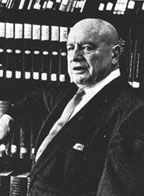Getting Stoned with the OSS
 |
| Harry Anslinger |
|
In the spring of 1942 General William "Wild Bill" Donovan, chief of the Office of
Strategic Services (OSS), the CIA's wartime predecessor, assembled a half-dozen
prestigious American scientists and asked them to undertake a top-secret research
program. Their mission, Donovan explained, was to develop a speech-inducing drug for
use in intelligence interrogations. He insisted that the need for such a weapon was so
acute as to warrant any and every attempt to find it. The OSS chief pressed his associates
to come up with a substance that could break down the psychological defenses of enemy
spies and POWs, thereby causing an uninhibited disclosure of classified
information. Harry J. Anslinger, head of the Federal Bureau of Narcotics, was a member of this committe, which surveyed and rejected numerous drugs, including alcohol, barbiturates, and caffeine. Peyote and scopolamine were also tested, but the visions produced by these substances interfered with the interrogation process. Eventually marijuana was chosen as the most likely candidate for a speech-inducing agent. OSS scientists created a highly potent extract of cannabis, and through a process known as esterification a clear and viscous liquid was obtained. The final product had no color, odor, or taste. It would be nearly impossible to detect when administered surreptitiously, which is exactly what the spies intended to do. "There is no reason to believe that any other nation or group is familiar with the preparation of this particular drug," stated a once classified OSS document. Henceforth the OSS referred to the marijuana extract as "TD" --a rather transparent cover for "Truth Drug." The effects of TD were described in an OSS report: "TD appears to relax all inhibitions and to deaden the areas of the brain which govern an individual's discretion and caution. It accentuates the senses and makes manifest any strong characteristics of the individual. Sexual inhibitions are lowered, and the sense of humor is accentuated to the point where any statement or situation can become extremely funny to the subiect. On the other hand, a person's unpleasant characteristics may also be heightened. It may be stated that, generally speaking, the reaction will be one of great loquacity and hilarity." This was a rather mild and playiul assessment of the effects of marijuana compared to the public rantings of Anslinger, the narcotics chief who orchestrated an unrelenting media compaign against "the killer weed." After testing TD on themselves, their associates, and US military personnel, OSS agents utilized the drug operationally, although on a limited basis. The results were mixed. In certain instances TD subjects felt a driving necessity "to discuss psychologically charged topics. Whatever the individual is trying to withhold will be forced to the top of his subconscious mind." But there were also those who experienced "toxic reactions"--better known in latter-day lingo as "bummers." One unwitting doper became irritable and threatening and complained of feeling like he was "two different people." The peculiar nature of his symptoms precluded any attempt to question him. That was how it went, from one extreme to the other. At times TD seemed to stimulate "a rush of talk"; on other occasions people got paranoid and didn't say a word. The lack of consistency proved to be a maior stumbling block, and "Donovan's dreamers," as his enthusiastic OSS staffers have been called, reluctantly weaned themselves from their reefer madness. A handwritten comment in the margins of an OSS document summed up their stoned escapades: "The drug defies all but the most expert and searching analysis, and for all practical purposes can be considered beyond analysis." |
An excerpt from Acid Dreams: The Complete Social History of
LSD: The CIA, the Sixties and Beyond, by Martin A. Lee and Bruce Shlain
(Grove Press)
Copyright 1985 by Martin A. Lee and Bruce Shlain
The Acid Dreams web site: http://www.levity.com/aciddreams/